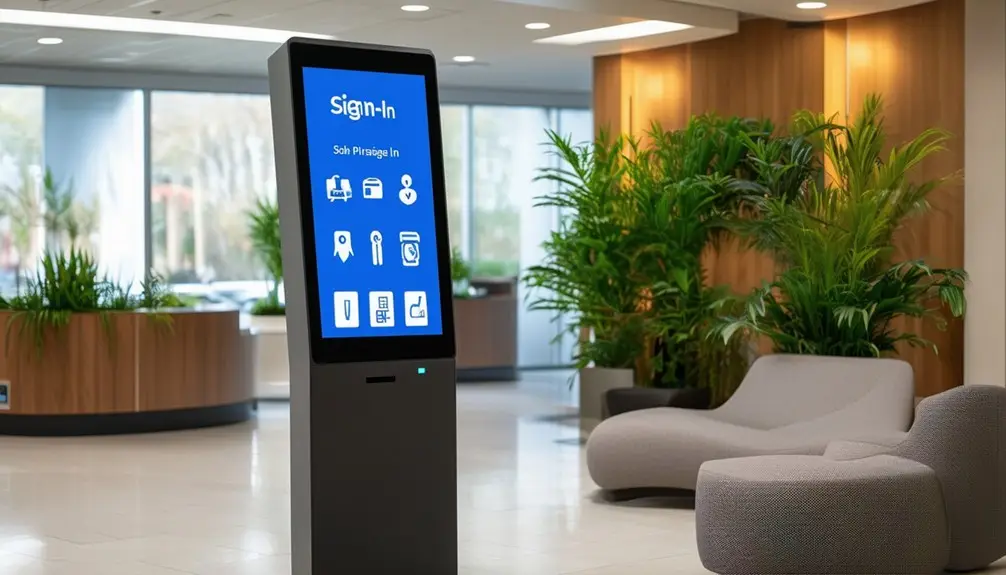Digital sign-in kiosks for clinics streamline patient flow and reduce check-in time by up to 75%. They enhance data accuracy, bolster privacy, and integrate seamlessly with EHR systems. These kiosks use secure data handling methods like HTTPS, SSL/TLS, and encryption for patient data. With role-based access controls and detailed audit trails, they guarantee HIPAA compliance. Durable, ADA-compliant hardware facilitates easy maintenance and accessibility. Features include touch screen interfaces, mobile-friendly options, and automated notifications for staff. For more insights on improving patient experience and operational efficiency, continue exploring further.
Table of Contents
ToggleKey Takeaways
- Digital kiosks reduce patient check-in time by up to 75%, improving clinic efficiency.
- Enhance data accuracy and secure data handling, ensuring HIPAA compliance.
- Streamline patient flow with real-time staff notifications and automated data entry.
- Mobile integration allows contactless check-ins via smartphones, supporting social distancing.
- Durable, ADA-compliant kiosks with non-porous finishes ensure long-term reliability and hygiene.
Benefits of Digital Sign-In Kiosks
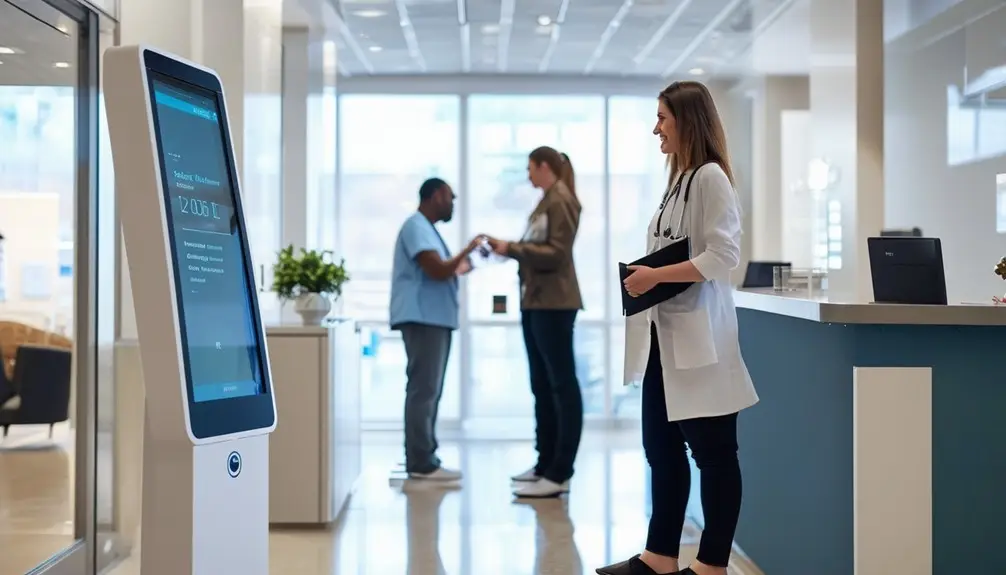
By implementing digital sign-in kiosks, clinics can reduce patient check-in time by up to 75%, improving both efficiency and patient satisfaction. These kiosks streamline the check-in process, allowing patients to quickly enter their information without waiting for front desk staff. As a result, the waiting room experience greatly improves, with reduced congestion and shorter wait times.
One key advantage is the enhancement of data accuracy. Digital kiosks minimize errors by guiding patients through a structured input process, making sure that necessary information is captured correctly. This integration with your clinic’s patient tracking systems ensures smooth operations, allowing staff to access real-time data and manage patient flow more effectively.
Additionally, digital sign-in kiosks bolster privacy and HIPAA compliance. By eliminating paper sign-in sheets that might expose patient information, these kiosks provide a secure, confidential method for patients to check-in. This added layer of data security is essential in maintaining patient trust and adhering to regulatory standards.
Patient Sign-In Kiosk Features
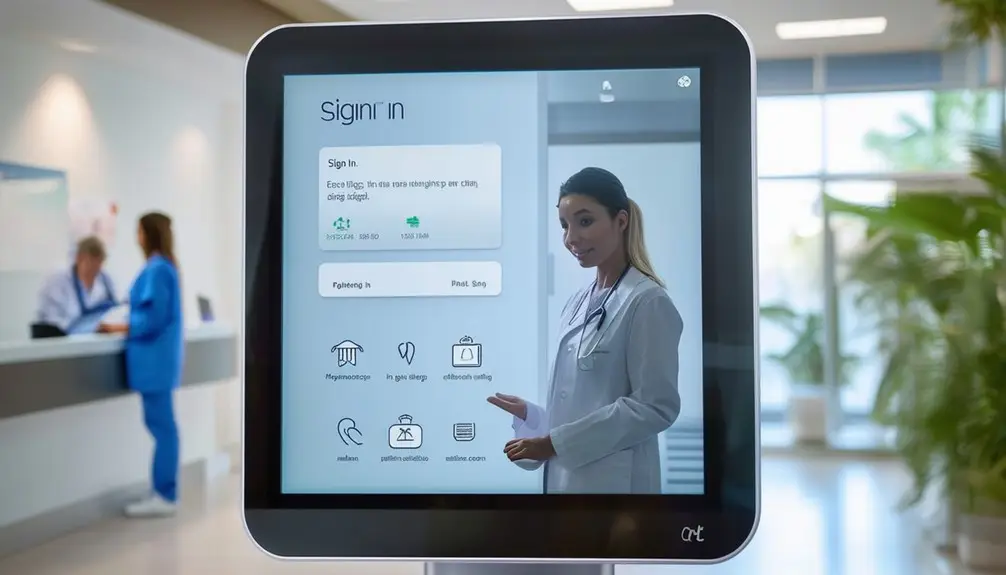
Focusing on the specific functionalities, patient sign-in kiosks boast features like real-time data integration, automated notifications, and secure data handling to streamline clinic operations. These healthcare kiosks eliminate the tedious process of manual data gathering, replacing traditional paper sign-in sheets with a more efficient and accurate system. You’ll find that they address HIPAA compliance challenges by guaranteeing patient information is securely recorded and managed.
These kiosks also play a critical role in keeping your clinic’s waiting room running smoothly. By notifying staff of patient arrivals in real-time, you can reduce wait times and improve overall patient flow. Additionally, the integrated system software and hardware provide seamless operation, ensuring that your clinic’s processes are not disrupted.
Consider these key features:
- Real-Time Data Integration: Automatically syncs patient information with your clinic’s database.
- Automated Notifications: Alerts staff immediately when a patient checks in.
- Secure Data Handling: Guarantees all patient data is encrypted and compliant with HIPAA standards.
- Seamless System Integration: Combines software and hardware for smooth functionality.
Utilizing healthcare kiosks can transform how your clinic manages patient sign-ins, making the overall process more efficient and secure.
Touch Screen Sign-In Advantages
You’ll find that touchscreen sign-in kiosks enhance data accuracy by reducing manual data entry errors and ensuring information is directly integrated into your system. They also improve privacy compliance by eliminating paper sign-in sheets and addressing HIPAA challenges effectively. Additionally, these kiosks facilitate efficient patient flow by organizing arrivals and notifying staff through integrated channels.
Enhanced Data Accuracy
How can touchscreen sign-in kiosks enhance data accuracy in clinics by eliminating manual entry errors? By leveraging these modern kiosks, you reduce the chances of human error that can occur with manual data entry. This not only boosts data accuracy but also guarantees that patient information is captured correctly and efficiently.
Touchscreen sign-in kiosks come with several technical advantages:
- Automated Data Entry: Patients input their own information, reducing transcription errors.
- Real-Time Updates: The system updates patient records instantly, ensuring all data is current.
- Secure Data Handling: Enhanced security protocols safeguard patient data, complying with HIPAA standards.
- System Integration: These kiosks seamlessly integrate with existing Electronic Health Records (EHR) systems, maintaining data consistency across platforms.
Efficient Patient Flow
By leveraging touchscreen sign-in kiosks, clinics can streamline patient flow, reduce wait times, and enhance overall efficiency through accurate check-in records and real-time staff notifications. These kiosks eliminate the need for manual data entry, replacing cumbersome paper sign-in sheets with a seamless digital process. This change not only speeds up the check-in procedure but also greatly enhances the patient experience by minimizing delays and confusion.
Touchscreen kiosks accurately record the exact time a patient checks in, making sure that staff are immediately notified of their arrival. This integration with patient tracking systems allows for efficient management and reduces bottlenecks in the workflow. Patients can also use mobile devices for a mobile-friendly sign-in process, adding another layer of convenience and accessibility.
The automated nature of these kiosks enhances office organization and overall efficiency. By collecting and processing data electronically, clinics can ensure patient information is accurately captured and securely stored. This digital approach not only improves operational efficiency but also contributes to a more positive patient experience, as the entire check-in process becomes faster and more reliable.
Improved Privacy Compliance
Touch screen sign-in kiosks enhance privacy compliance by eliminating the need for insecure paper sign-in sheets, guaranteeing patient data is confidential and secure. These kiosks address HIPAA compliance challenges by securely recording patient check-in times, which improves both data accuracy and organization. By opting for digital sign-in systems, you minimize the risk of unauthorized access to sensitive patient information that is often prevalent with traditional paper methods.
Here are some key benefits of using touchscreen sign-in kiosks for privacy compliance:
- Enhanced Security: Data is encrypted and stored securely, reducing the risk of data breaches.
- Accurate Records: Automatically time-stamped entries ensure precise and organized patient records.
- Streamlined Notifications: Patients can effortlessly notify staff of their arrival, improving workflow efficiency.
- Smooth Operations: A well-integrated system keeps the waiting room running smoothly, enhancing patient satisfaction.
Mobile Integration for Check-In
Mobile integration for check-in enhances clinic efficiency and patient satisfaction by allowing secure, contactless entry via smartphones. By leveraging mobile integration, patients can use their devices to check in, eliminating the need for physical touchpoints. This system employs QR codes to guarantee secure proximity-based check-ins, adding an additional layer of security.
You can place QR codes at various entry points, facilitating social distancing by expanding waiting areas. This strategic placement optimizes the flow of patients, reducing congestion in waiting rooms and minimizing physical contact, which is essential for infection control.
Implementing mobile check-in solutions streamlines the check-in process, offering patients a convenient and efficient way to register their arrival. The data from these mobile interactions integrates seamlessly with your clinic’s existing electronic health record (EHR) systems, ensuring a smooth and efficient workflow.
This contactless check-in via mobile devices not only improves operational efficiency but also enhances patient satisfaction by offering a modern, convenient alternative to traditional check-ins. Embracing mobile integration in your clinic’s check-in process can transform patient interactions, making them more secure and efficient while maintaining high standards of data security and system integrity.
Ensuring HIPAA Compliance
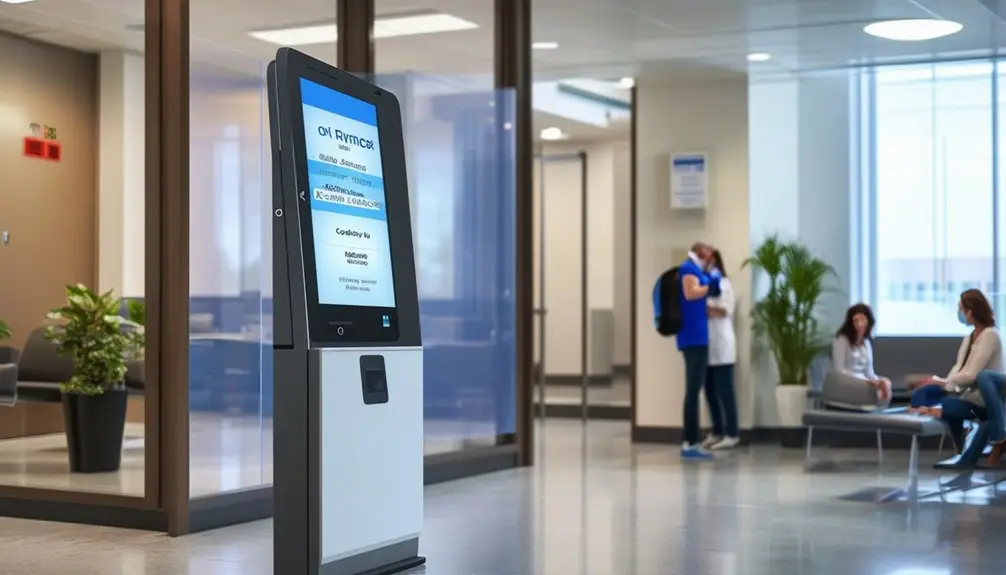
Securing HIPAA compliance in digital sign-in kiosks involves implementing robust encryption and secure data transmission protocols to protect patient information. To meet HIPAA standards, you’ll need to focus on several critical aspects of data security and system integration. These kiosks must not only store patient information securely but also follow strict privacy protocols to prevent unauthorized access.
Here are some essential elements for ensuring HIPAA compliance in your digital sign-in kiosks:
- Encryption: Encode patient data both at rest and in transit to guarantee that sensitive information is unreadable to unauthorized users.
- Secure Data Transmission: Use secure transmission methods such as HTTPS and SSL/TLS to safeguard data as it moves between the kiosk and your servers.
- Access Control: Implement role-based access controls to limit access to sensitive information based on user roles and responsibilities.
- Audit Trails: Maintain detailed audit logs to track access and modifications to patient data, aiding in monitoring and compliance verification.
Organizational Efficiency and Reporting
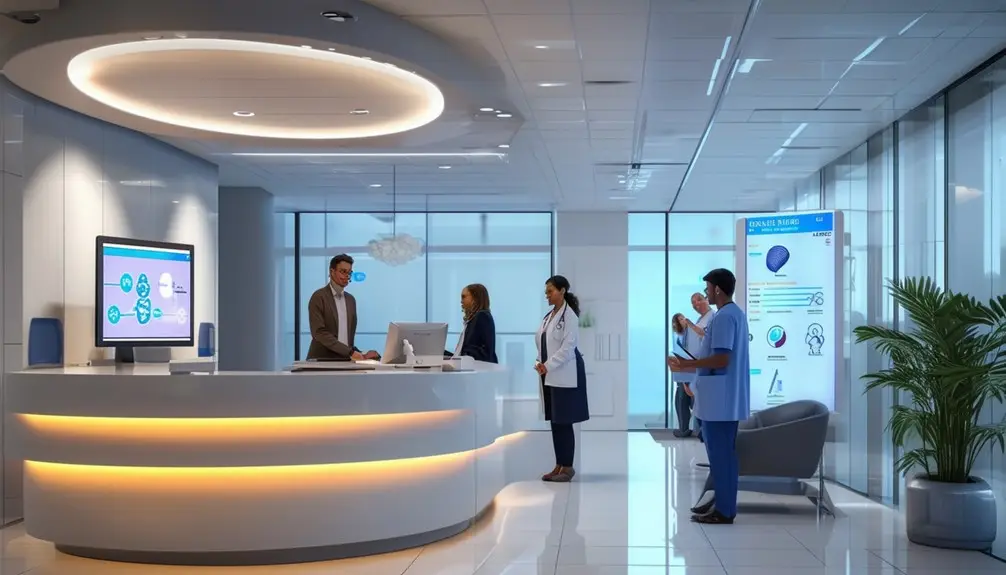
Implementing digital sign-in kiosks can significantly boost organizational efficiency by streamlining patient check-ins and providing real-time data for thorough management reports. The kiosks automatically sort and organize patient information, which optimizes your office workflow and minimizes bottlenecks. By integrating these kiosks with your existing systems, you guarantee seamless data collection and sharing across your entire clinic.
Real-time data collection is a game-changer for generating management reports. These reports offer valuable insights into office performance, patient flow, and staffing needs. You can make informed decisions quickly, improving both operational efficiency and patient satisfaction. The data captured also helps identify peak times, allowing you to allocate resources more effectively.
Additionally, digital sign-in kiosks enhance data security. By reducing manual entry points, you minimize the risk of human error and unauthorized access to sensitive patient information. The kiosks can be configured to comply with industry standards, safeguarding that all collected data is securely stored and transmitted.
Kiosk Hardware Specifications
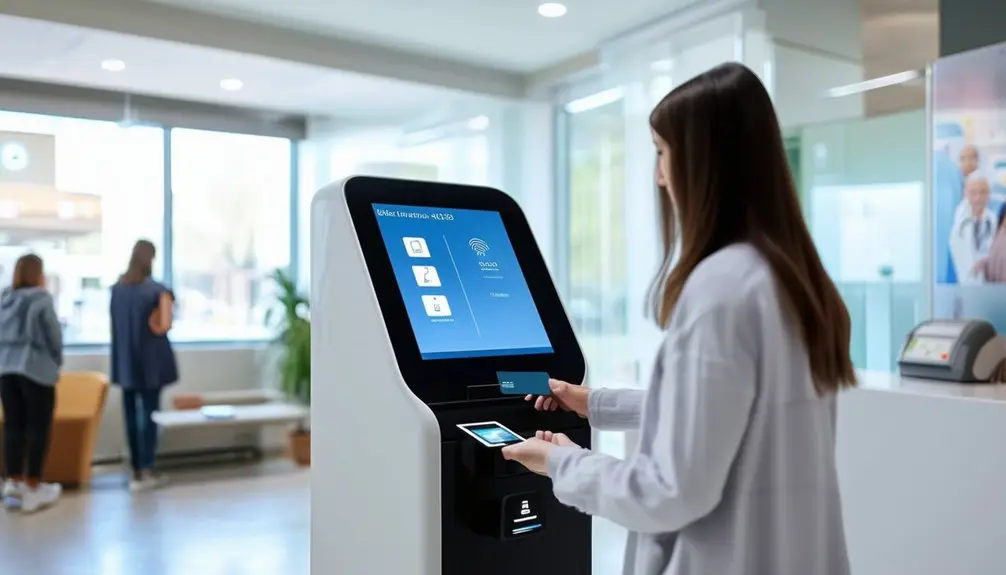
When selecting kiosk hardware for your clinic, you’ll appreciate the durable construction materials such as powder-coated steel and industrial-grade thermoplastics. These kiosks are built to last, coming with a full 5-year warranty and meeting ADA Compliance standards for accessibility, including optional Braille and audio features. Their non-porous finishes guarantee easy sanitization, preserving a clean and secure environment for all users.
Durable Construction Materials
Constructed from powder-coated steel and industrial-grade thermoplastics, digital sign-in kiosks for clinics offer robust durability and ease of maintenance, meeting strict ADA compliance standards for accessibility. These durable construction materials guarantee the kiosks can withstand the high-traffic environments typical of healthcare settings. The kiosks also come with a full 5-year warranty, highlighting their longevity and reliability.
To enhance their practical use, the kiosk hardware features non-porous finishes, making them easy to sanitize and maintain hygiene standards. This is especially vital in medical environments where cleanliness is paramount. The design does not compromise on functionality, seamlessly integrating with existing clinic systems to guarantee a smooth and secure patient sign-in process.
Key features include:
- Powder Coated Steel: Provides a sturdy framework resistant to scratches and corrosion.
- Industrial-Grade Thermoplastics: Offers impact resistance and flexibility.
- Non-Porous Finishes: Facilitates easy cleaning and disinfection.
- Full 5-Year Warranty: Ensures long-term performance and reliability.
Compliance and Accessibility
Guaranteeing compliance and accessibility, digital sign-in kiosks for clinics are designed to meet strict ADA standards, incorporating features like Braille and audio access to accommodate all patients. These kiosks are constructed from powder-coated steel and industrial-grade thermoplastics, ensuring both durability and ease of maintenance. The powder-coated steel provides a sturdy frame, while the non-porous thermoplastic surfaces make sanitization simple, promoting a hygienic environment crucial in healthcare settings.
To support long-term reliability and ease of integration into your clinic’s operations, the hardware comes with a full 5-year warranty. This guarantees that any issues can be promptly addressed, reducing downtime and maintaining patient flow efficiency. Optional features such as Braille and audio access buttons ensure that the kiosks are inclusive, making it easier for patients with disabilities to sign in without needing assistance from staff.
Seamlessly integrating these kiosks into your clinic’s existing systems enhances data security by allowing secure, direct input of patient information. This reduces the risk of data breaches and guarantees that sensitive patient information is handled securely. Investing in ADA-compliant, durable, and hygienic kiosks ultimately supports both your clinic’s operational efficiency and commitment to patient care.
Common Use Cases in Healthcare
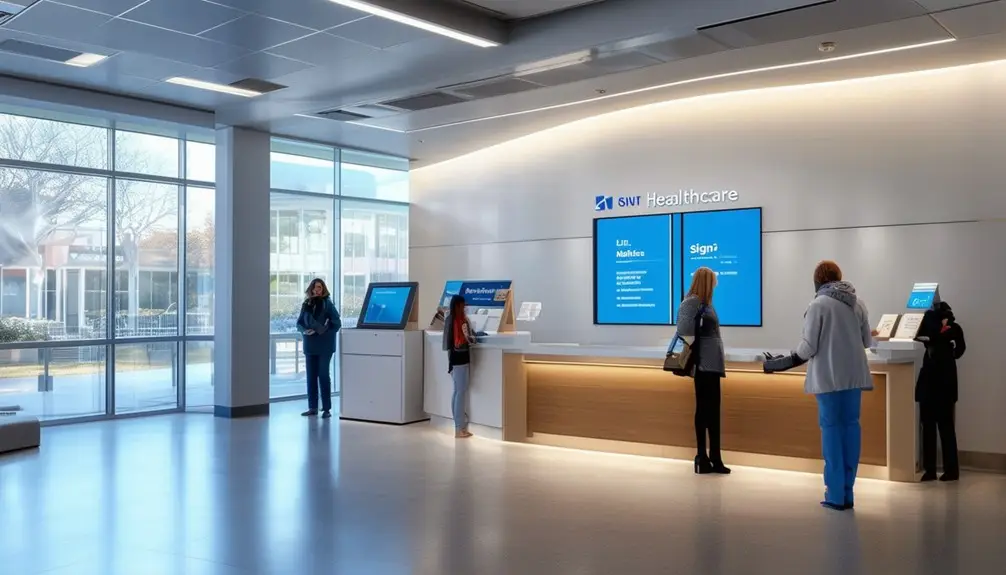
Digital Sign-In Kiosks are widely adopted in healthcare settings like lab centers, outpatient services, and radiology centers to streamline patient check-ins and integrate seamlessly with patient tracking systems. Healthcare facilities benefit greatly from these kiosks by optimizing their workflow and guaranteeing data accuracy.
Here are some common use cases:
- Lab Centers: Digital kiosks can facilitate quick and efficient patient check-ins, reducing long wait times and ensuring precise sample tracking.
- Outpatient Services: These kiosks help manage the high volume of patients by automating the registration process, allowing staff to focus on patient care.
- Radiology Centers: By integrating with radiology information systems (RIS), kiosks guarantee that patient data is accurately recorded and easily accessible for imaging procedures.
- Specialty Clinics: Kiosks can manage complex appointment schedules and patient intake forms, ensuring that each visit is well-documented and streamlined.
Enhancing Patient Experience
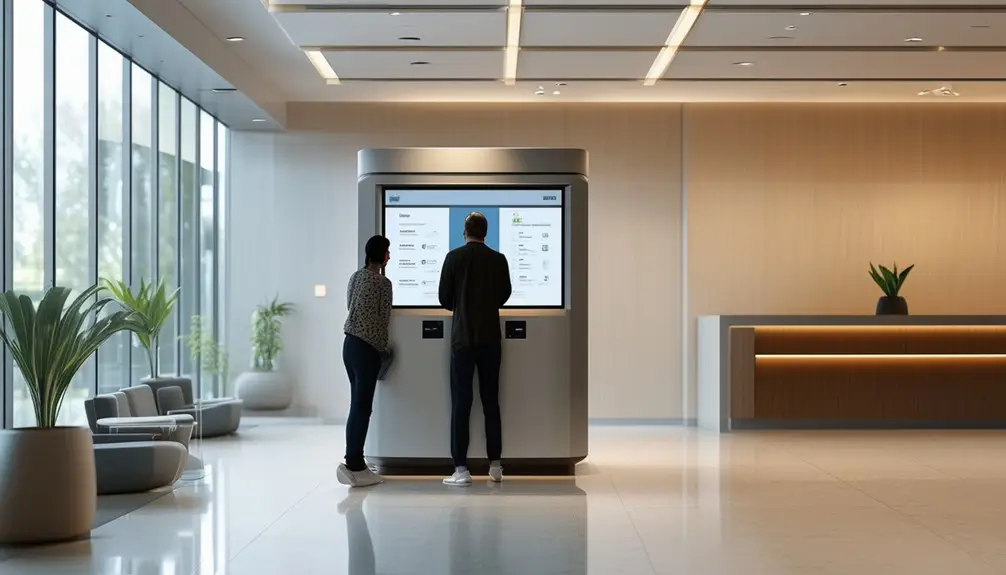
Implementing digital sign-in kiosks can significantly enhance the patient experience by reducing wait times and streamlining the check-in process. These kiosks cut patient waiting times by up to 35%, notably improving your clinic’s efficiency. You can make sure that patient check-in times are accurately recorded, which not only helps in managing patient flow but also boosts overall satisfaction.
Patients can easily notify clinic staff of their arrival using touch screen sign-in kiosks, expediting the entire check-in process. By integrating mobile technology, you allow patients to interact with the kiosks using their smartphones, further enhancing convenience and accessibility. This seamless integration helps in reducing bottlenecks and makes the registration process faster and more user-friendly.
Implementing electronic sign-in sheets through these digital kiosks ensures HIPAA compliance, enhancing patient privacy and data security. This technological upgrade not only organizes clinic operations but also builds trust with patients by safeguarding their personal information. By focusing on technical expertise, data security, and system integration, digital sign-in kiosks can transform the patient experience, making it smoother, faster, and more secure.
Conclusion
In the digital age, integrating sign-in kiosks at your clinic isn’t just a convenience—it’s a game-changer. You’ll streamline operations, enhance patient experiences, and bolster data security. Imagine your clinic running like a well-oiled machine, where every touchpoint is optimized. With mobile integration and stringent HIPAA compliance, you’re not just keeping up with technology; you’re leading the charge. Embrace the future, and transform your clinic into a beacon of efficiency and patient satisfaction.
Frequently Asked Questions
What Is Healthcare Digital Signage?
Healthcare digital signage involves using digital displays, enclosures, and specialized software to streamline tasks and enhance patient experiences. You’ll see it providing information, directions, and live updates, improving communication, reducing stress, and enhancing overall efficiency.
What Are Kiosks Used for in Healthcare?
You’ll find kiosks in healthcare used for streamlining check-ins, patient data management, and improving office efficiency. They’re HIPAA compliant, ensuring data security and integrating seamlessly with tracking systems to offer immediate operational benefits.
What Is the Purpose of a Digital Kiosk?
By juxtaposing efficiency with security, you see the purpose of a digital kiosk: it streamlines processes while ensuring data protection. It integrates seamlessly with systems, enhancing workflow and maintaining compliance with data security regulations.
